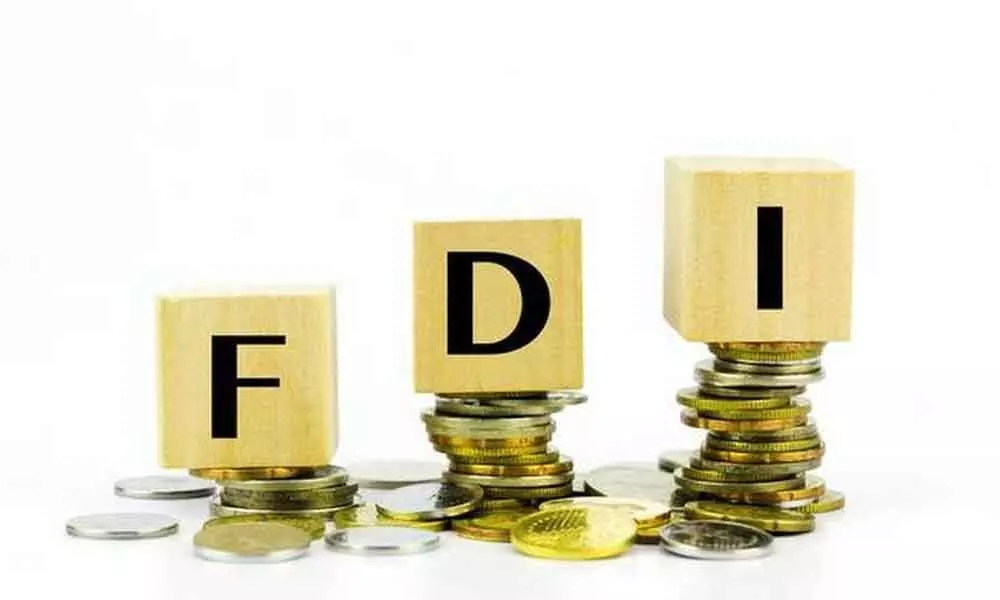Live
- Nizamabad MP Dharmapuri Arvind and Jagtial MLA Dr. Sanjay Kumar Meet CM Revanth Reddy
- Hyderabad CP CV Anand Issues Stern Warning to Bouncers
- MP Laxman Criticizes Police Conduct, Calls for Support for Victims' Families
- Fire Breaks Out in Kachiguda-Chennai Egmore Express, Passengers Evacuated Safely
- CM Revanth Reddy Condemns Attacks on Film Personalities' Homes, Calls for Strict Action
- Victory Venkatesh and Nandamuri Balakrishna to Set Screens on Fire with Unstoppable Season 4
- Over 71.81 crore Ayushman Bharat Health Account numbers generated: Centre
- In special gesture, Kuwait's Prime Minister sees-off PM Modi at airport after conclusion of historic visit
- Veer crowned PGTI Ranking champion, Shaurya wins emerging player honour
- Sr National Badminton: Unseeded Rounak Chauhan, Adarshini Shri reach singles semis
Just In
India among top 10 FDI recipients last year: United Nations


India was among the top 10 recipients of Foreign Direct Investment in 2019, attracting $49 billion in inflows, a 16 per cent increase from the previous year, driving the FDI growth in South Asia, according to a UN report released on Monday.
United Nations: India was among the top 10 recipients of Foreign Direct Investment in 2019, attracting $49 billion in inflows, a 16 per cent increase from the previous year, driving the FDI growth in South Asia, according to a UN report released on Monday.
The Global Investment Trend Monitor report compiled by United Nations Conference on Trade and Development (UNCTAD) states that the global foreign direct investment remained flat in 2019 at $1.39 trillion, a 1 per cent decline from a revised $1.41 trillion in 2018.
This is against the backdrop of weaker macroeconomic performance and policy uncertainty for investors, including trade tensions, it said. Developing economies continue to absorb more than half of global FDI flows.
South Asia recorded a 10 per cent increase in FDI to $60 billion and "this growth was driven by India, with a 16 per cent increase in inflows to an estimated $49 billion.
The majority went into services industries, including information technology," the report said.
India attracted an estimated $49 billion of FDI in 2019, a 16 per cent increase from the $42 billion recorded in 2018, it said.
The FDI flows to developed countries remained at a historically low level, decreasing by a further 6 per cent to an estimated $643 billion.
The FDI to the European Union (EU) fell by 15 per cent to $305 billion, while there was zero-growth of flows to United States, which received $251 billion FDI in 2019, as compared to $254 billion in 2018, the report said.
Despite this, the United States remained the largest recipient of FDI, followed by China with flows of $140 billion and Singapore with $110 billion.
China also saw zero-growth in FDI inflows. Its FDI inflows in 2018 were $139 billion and stood at $140 billion in 2019.
The FDI in the UK was down 6 per cent as Brexit unfolded. The report added that cross-border M&As decreased by 40 per cent in 2019 to $490 billion – the lowest level since 2014.
Slowed down by sluggish Eurozone growth and Brexit, European M&A sales halved to $190 billion. Deals targeting United States companies remained significant – accounting for 31 per cent of total M&As.
The fall in global cross-border M&As sales was deepest in the services sector (a 56 per cent decline to $207 billion), followed by manufacturing (a 19 per cent decline to $249 billion) and primary sector (14 per cent decline to $34 billion), the report said.
In particular, sales of assets related to financial and insurance activities and chemicals fell sharply. The decline in M&A values was driven also by a lower number of megadeals. In 2019, there were 30 megadeals above $5 billion compared to 39 in 2018, it said.
Looking ahead, UNCTAD expects the FDI flows to rise moderately in 2020, as current projections show the global economy to improve somewhat from its weakest performance since the global financial crisis in 2009.
Corporate profits are expected to remain high and signs of waning trade tensions emerge. However, the decrease of announced greenfield projects by 22 per cent – an indicator of future trends, high geopolitical risks and concerns about a further shift towards protectionist policies temper expectations.
The report said that GDP growth, gross fixed capital formation and trade are projected to rise, both at the global level and, especially, in several large emerging markets.
Such an improvement in macroeconomic conditions could prompt MNEs to resume investments in productive assets, given also their easy access to cheap money, the fact that corporate profits are expected to remain solid in 2020, and hopes for waning trade tensions between the United States and China, it said.

© 2024 Hyderabad Media House Limited/The Hans India. All rights reserved. Powered by hocalwire.com






